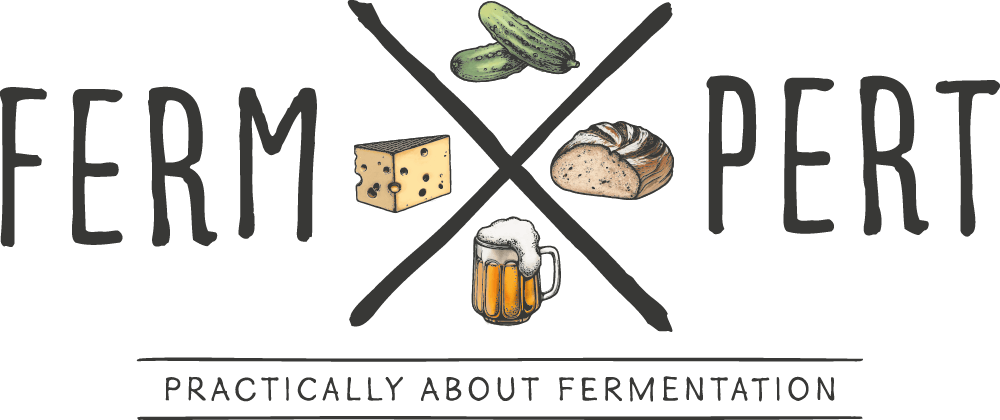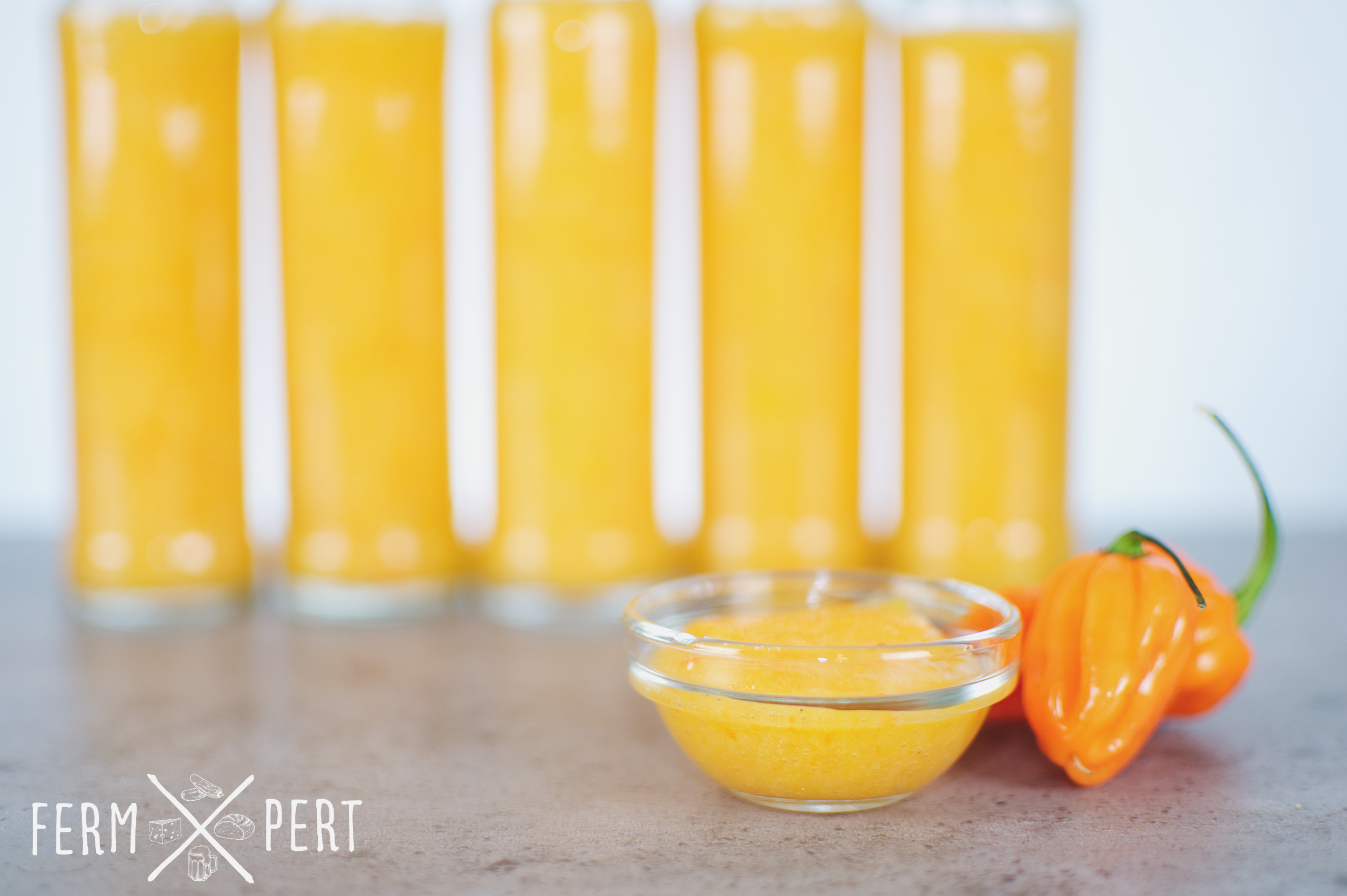My fridge always holds a few open jars of hot sauce. I have with with everything, from eggs, through meats, cheeses, sandwiches, to salad dressings. And the home made ones are the tastiest, obviously. Below, I present one of my simplest hot sauce recipes.
Przepis
- 300 g fresh pineapple
- 300 g yellow bell pepper
- 70 g orange Habaneros
- 15 g yellow Trinidad Moruga Scorpion
- 100 g 6% apple cider vinegar
- 50 g water
- 6 g salt
- 12 g sugar (optional)
- 3 g xanthan gum (optional)
The spicy peppers can be swapped for other varieties. The Habaneros are easy to obtain, but the Trinidad Moruga Scorpion can be quite challenging to find. It can just be swapped for a few more Habaneros.
The proportions given should result in a heat level of slightly below 50 thousand Scoville units, so it’s very spicy, but not necessarily tear squeezing.
The pineapple should be peeled and cleaned from eyes and seeds. The bell pepper – cored and seeded. The spicy peppers – roughly chopped, e.g. cut into quarters.
Place the chopped ingredients in a blender. Add salt, water and vinegar, then blend until smooth. Taste and if needed, add sugar. Finally, add the xanthan gum and blend for a moment so it’s evenly dispersed.
Transfer the sauce to a pan and heat it up until it boils. Pour into jars while it’s still hot, then pasteurise for a short time (5-10 minutes is sufficient, depending on the jar diameter). It’s possible to use the oven for this, but it’s best to prolong the pasteurisation time to 30 minutes or so.
The sauce should have a shelf life of a minimum of one year. After opening a jar, store it in the fridge and consume within a month.
Additional Information
Xanthan gum is a thickening agent, but above all, an emulsifier. This means that the sauce shouldn’t separate. Its use is entirely optional. In case it’s omitted, the sauce should be shaken well before each use.
The ingredient proportions are adjusted to my personal preferences and as such, they can be experimented with. The vinegar solution is about 25% of the pineapple and peppers’ total mass (in reality a bit less as I excluded the spicy peppers from the calculation in order to keep the numbers more elegant). Its acetic acid concentration is 4%. The formulae to calculate the exact proportions of water and vinegar can be found in a dedicated blog post.
The amount of pineapple is a result of experimentation with previous batches of my sauces. The aim is to make is easily perceivable, but not dominating, and the proportion I came up with is 50% of the total mass of fruit (again, a bit less in reality due to the exclusion of the chillies). Other types of fruit, such as peaches or mangoes, require a similar proportion.
The mass of the chillies depends on their heat level. I always aim for a 25-75 thousand SHU range, but that’s just my preference. I calculated this sauce’s theoretical heat level to be between 15569 and 65269 SHU (the minimum and maximum values are based on the SHU ranges for different chilli varieties), which gives an average of 40419 SHU. The formula for calculating a sauce’s heat level can be found in a dedicated blog post.
Video Transcription
I admit freely: I like spicy foods. My heat tolerance might not be the greatest in the world, but still I rarely go a day without a dab of something really hot. Today I’m making a very simple, yet flavourful sweet and spicy sauce. A written recipe with ingredient amounts and more information can be found on the blog.
I’m going to use a few pepper types. A sweet yellow bell pepper, a handful of orange Habaneros and a single frozen yellow Trinidad Moruga Scorpion that I harvested a few weeks prior. A pineapple will provide a delightful tropical sweetness. I’ll also need salt, sugar, vinegar and an optional ingredient: xanthan gum.
I start by preparing the pineapple. I’m not making a whole lot of sauce, so I’ll only need half of it. It’s going to be 50% of the sauce’s mass. I slice off the bottom. Then, I slice the peel off of the sides. Once I’m done, I remove the eyes by cutting diagonal lines along the eye rows. Finally, I remove the core. Mmh, it’s very sweet. I happen to have prepared a tad too much, which means there’s another piece for me!
I core and seed a single bell pepper. Then I roughly dice it. I toss it directly in the blender. While I’m at it, I also chop and toss in the pineapple.
I proceed to chop the hot peppers. First, the Scorpion. I leave the seeds in for an extra fiery kick. Then, I repeat the process with the Habaneros.
I prepare the blender. I toss in the salt and the sugar. I also pour in the vinegar to thin down the mixture. The blender will have an easier job this way. Once the sauce is fairly smooth, I add the xanthan gum. This will ensure the sauce’s liquid and solid parts don’t separate. The smell is rather choking at this point, as usual with hot peppers. I give it a quick taste before the next step. It’s very tasty, although maybe a tad too sweet. Perhaps I shouldn’t have added the sugar straight away. Oh well…
Xanthan gum is created by the bacteria Xanthomonas campestris via fermentation of glucose and sucrose. It is a polysaccharide that behaves similarly to dietary fibre. It is not digested by the human body, but instead it serves as food for gut bacteria. It’s perfectly safe for consumption.
I pour the sauce into a pan. This isn’t a fermented sauce, but the raw ingredients would have brought a lot of bacteria in. With all the carbs from the peppers, the pineapple and the sugar, the sauce would start fermenting immediately. I don’t want that. This is a vinegar based sauce and I need to heat it up to pasteurise it.
I turn the heat on and stir the sauce until it starts to boil. I spot a few pineapple seeds so I remove them. I simmer the sauce for a few minutes.
Once the sauce has simmered for long enough, I prepare a few clean jars. They have been sterilised by boling, and so have the lids. Using a funnel and a ladle with a spout, I fill the first jar. However, I realise the sauce is too thick to pass through the funnel quickly enough. I continue without the funnel. I manage to fill five jars. I screw on the lids.
Time to give the sauce another taste. It’s not overwhelmingly hot, but enough to satisfy my capsaicin cravings. The pineapple comes through nicely and the flavours are strong and as vibrant as the colour. It’s definitely on the sweet side, but should pair nicely with cheese and salty foods in general.
The last step is to pasteurise the sauce in jars. For that, I use the oven. It’s set to 100°C (212°F). I place the jars inside. They will stay there for half an hour, maybe an hour. After that, they should be able to sit in the cupboard for many months.

